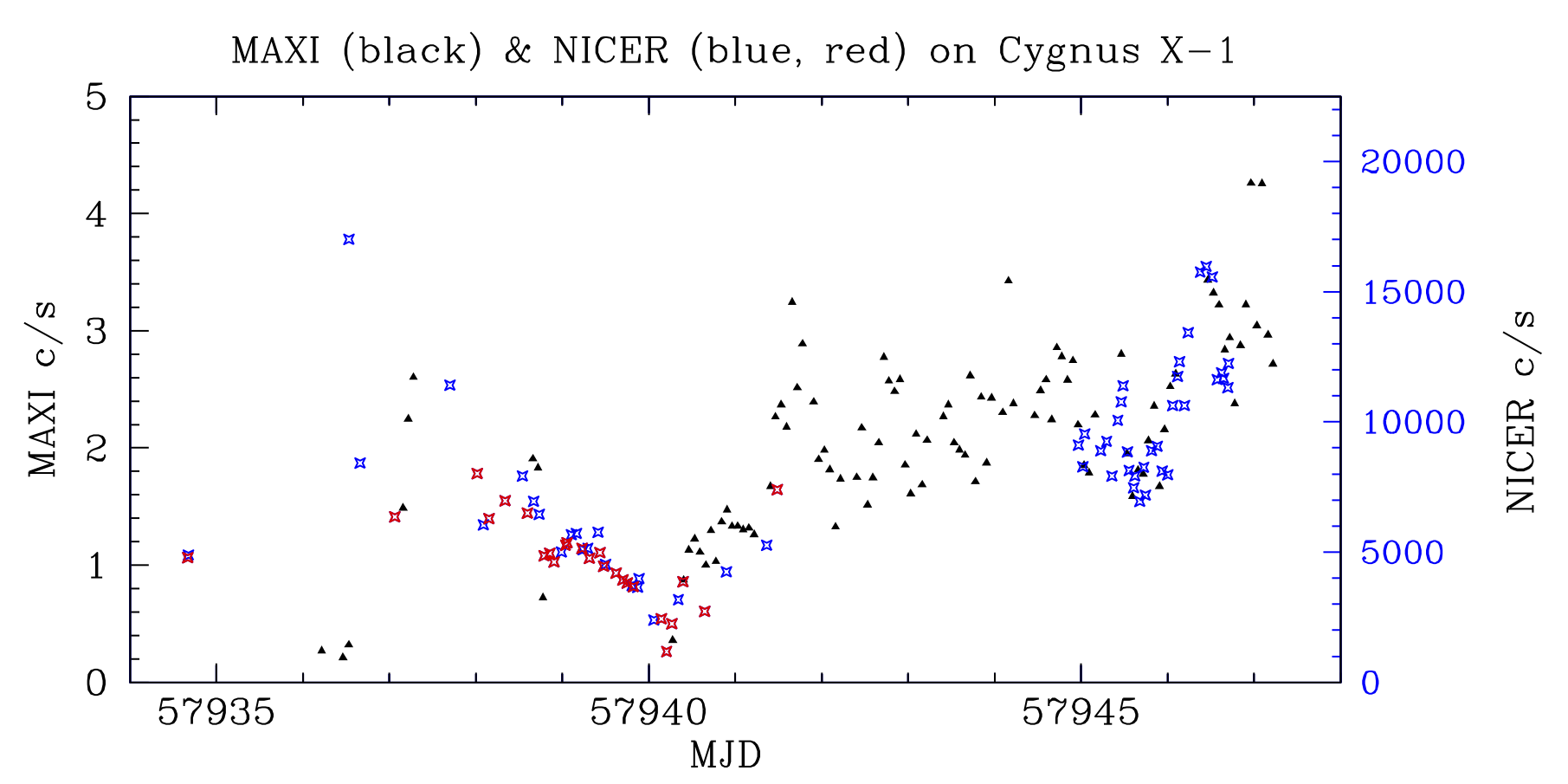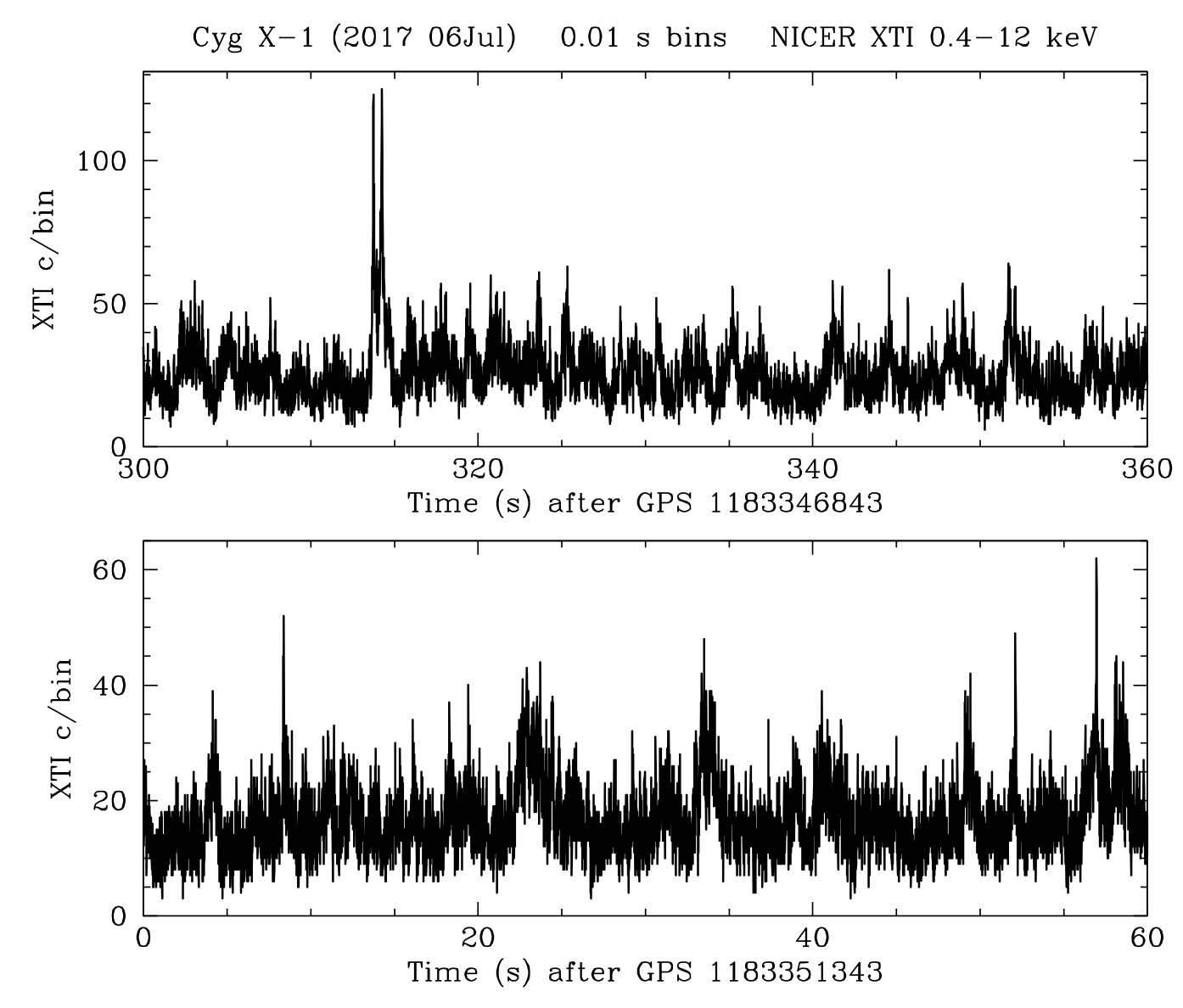NICER / ISS Science Nugget for October 20, 2017NICER Observes X-ray Flares from Cygnus X-1Cygnus X-1 is one of the first X-ray sources recognized as a black hole binary, i.e., a binary system consisting of a black hole (in this case, with 15 solar masses) that is accreting mass from its stellar companion (in this case, a 20 solar mass supergiant star). The gas swirling into the black hole becomes heated to millions of degrees, before it disappears at the black hole event horizon, and this heat produces a great X-ray glow that we can see thousands of light years away, across the Milky Way. Another interesting characteristic of Cyg X-1 is that the X-rays sometimes show intense flares that rise and fall with timescales in the range 1–100 msec. These flares are sometimes investigated in terms of "shot noise" characteristics (e.g., Pottschmidt et al, 1998, A&A, 334, 201). Investigators search for the most intense events to gain measurements of rise times, decay times, peak luminosities, and spectral changes. The goals are to determine their origin and their relationship to the smaller-amplitude variations that are very common in accreting black holes and neutron stars. Gierlinski & Zdziarski (2003, MNRAS, 343, L84) found 13 intense fast-flares in their inventory of 2.3 Ms of observations of Cyg X-1 with NASA's Rossi X-ray Timing Explorer (RXTE). In their search, they first measured the mean and sample standard deviation (sigma, or σ) for each interval of continuous exposure (~2 ks), and they then selected events with maxima that exceeded 10σ above the mean level. For the X-ray sources considered here, sigma is dominated by intrinsic flickering in the source, rather than fluctuations due to counting statistics, and so the 10σ search is tantamount to looking for events that are well past the range where log-normal statistics still governs the local behavior of the X-ray source. From these events, Gierlinski & Zdziarski found timescales and patterns of spectral evolution that differed, depending on whether Cyg X-1 was found to be in a "hard" or "soft" X-ray state. Uttley & McHardy (2001, MNRAS, 323, L26) also studied X-ray variations in Cyg X-1, and they discuss more physical interpretations of statistical analyses (i.e. links to large coronal flares or to the propagation of mass accretion fluctuations through the accretion disk). NICER made a series of observations of Cyg X-1 during 10 days near the end of the instrument commissioning period (2017 July). This netted 86 continuous exposure intervals with an average span of 10 minutes. This turned out to be a fortunate schedule choice. Radio observations showed that Cyg X-1 was producing unusually fast radio flares (6 min each) during August 2017 (Pooley at al. 2017, Atel. #10648), and our NICER observations captured fast flares in X-rays, several weeks earlier. Figure 1 shows the NICER intensity history for Cyg X-1 (blue and red crosses), superposed on the monitoring observation of the MAXI instrument (black triangles), which also operates from the International Space Station. Each plotted point for NICER represents the mean intensity of that exposure. We applied the sigma-based search criteria to the NICER data, using a bin size of 10 msec. We find 25 exposures (of the 86) containing one or more flares at the 7-sigma level, and these observations are plotted in Fig. 1 in red, rather than blue.
Two observations show peaks that exceeded 10-sigma. Both exposures were made on 2017 July 6, and their light curves are shown in Figure 2. The double-horned flare in the top panel is the most intense flare that we see, while the flares in the lower panel display the assortment in intensity/timescale that we have sampled.
Attention now shifts to the detailed analyses that may constrain the origin of these flares as either related to the energy source of the corona (perhaps magnetic reconnection events) or to changes we can tie to the accretion disk. Toward this goal, the notable advantages of NICER are its high count rates (higher than RXTE) and also its spectral window (0.2 – 12 keV). NICER affords visibility to both the disk and corona spectral components, something not possible with RXTE (mostly viewing the corona at 3 – 40 keV). NICER
|




